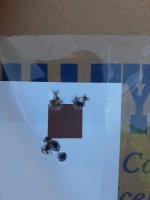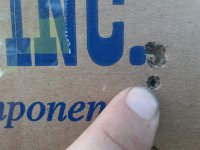100%!! there tends to be two camps here but generally both people are coming from two different points of view. Both are right yet wrong for the other.
I'm not sure how you could graph it out. I'm more of a numbers person then a visual.
But lets say from clean to 150 rounds my rifle shoots in the 3s. Around 150 I get more fliers then normal so ya... but I run my rifle in practice till I have 1500 rounds now I get no fliers but its a shitty shooting 1/2" gun now. Fair?
We will calculate expected groups at 200 yards (very common distance at our matches) as follows.
Velocity ES+ BC variation+ Group moa at 50.
Velocity ES is 25 fps or 1.9"
BC variation is 2% +/- so 0.5"
Clean 0.6 moa so 1.2"
Clean total = 3.6"
Dirty 1 moa so 2"
Dirty total = 4.4"
The difference is 0.8"
From round 5 to 100 I'd expect a 20-30 fps increase in velocity. A 1.5"-2.3" change in POI this turns your 3.6" group into a 5.1"-5.9" group in relation to POA.
Another factor to include is velocity change based on temperature. I have found a well fouled barrel to have a more consistent velocity as temp changes and more predictable velocity. Add in a 5 or 10 fps difference in actual velocity from your predicted velocity change through a match day and your difference from POA is +/- again depending on which way your off but how do you know?
What about velocity SD? There are a number of factors that affect SD and one of those for me has been a well fouled barrel. A 7 vs 9 SD will show up at 200 yards. That measly 2 fps which if we work back into our original calculation on group size rather then using a fixed ES would make our group size very similar. Depending on the level of certainty used to calculate the group sizes would be indistinguishable from each other.
Now all of a sudden those beautiful 50 yard groups clean are of no advantage in a longer range match. On the flip side the consistency and predictability of velocity in the fouled barrel make a real difference.
Having tested a clean barrel vs fouled at 200 yards many times I see no significant difference in group sizes. In fact all my best groups have been after 2000 plus rounds of fouling. But not enough to be what I'd call a statistically viable proof that dirty shoots better. Its the day to day no matter what weather consistency that makes the difference.
There are exceptions of course to this running a rifle "dirty" thing. CCI is one of those. And quite possibly others. I just run Eley any more so one lube. But Eley or Lapua both are good.
Alright now we can spin the story the other way hows my 0.5" gun going to hold out in a BR match? That 0.3" clean barrel is going to absolutely make my dirty rifle look stupid! So obviously I'm going to clean my rifle squeaky clean before such a match. Well actually in all honestly I wouldnt because then I'd have to get another couple bricks down range to get my consistency before the next PRS match...






